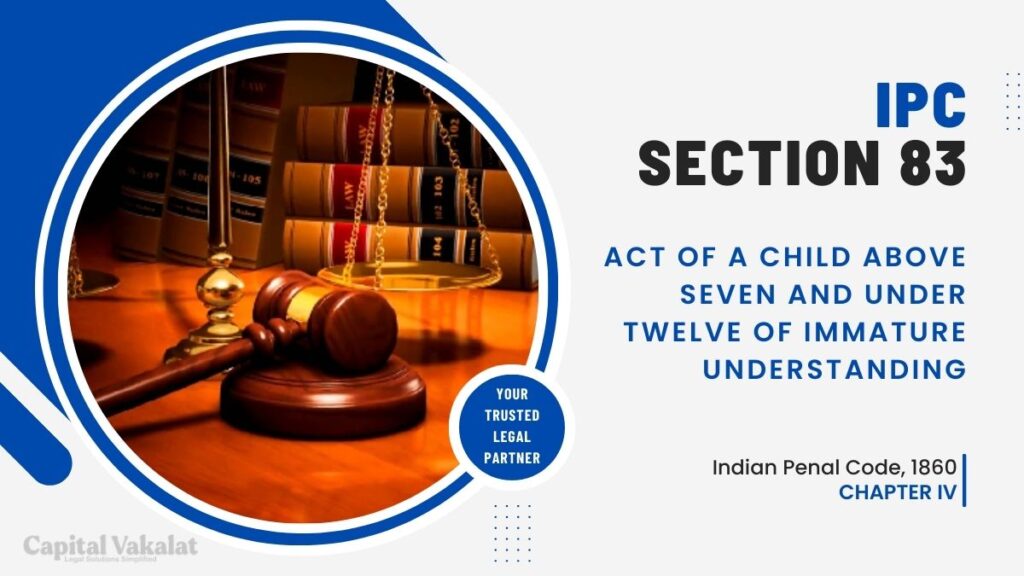In the vast realm of legal provisions and statutes, Section 83 of the Indian Penal Code (IPC) stands as a unique and distinctive clause that deals with a specific demographic within the society – children aged above seven and below twelve years with immature understanding. This provision recognizes that children of this age group possess a limited understanding of the consequences of their actions, and it establishes the legal framework for addressing their acts.

In this article, we will delve into the intricacies of Section 83 IPC, exploring its significance, implications, and the broader context of juvenile justice.
Understanding the Legal Landscape
Historical Perspective
The origins of Section 83 IPC can be traced back to the colonial era when the British introduced this provision to govern the actions of children in India. The law aimed to strike a balance between holding children accountable for their actions and recognizing their limited capacity for discernment.
Immature Understanding
One of the fundamental principles of Section 83 IPC is acknowledging that children between seven and twelve years old lack the maturity to comprehend the full consequences of their actions. It takes into account the cognitive and emotional development of children at this age, which is not fully formed.
Criminal Responsibility
Section 83 IPC outlines that no child under the age of twelve can be held criminally liable for their actions, regardless of the nature of the offense. This provision aligns with international standards on juvenile justice and prioritizes rehabilitation over punishment.
Exceptions
While Section 83 provides a broad exemption from criminal liability, it does have some exceptions. If it can be proved that a child between seven and twelve years old possessed a sufficient understanding of the nature and consequences of their actions, they may be held accountable for their behavior.
Significance in Juvenile Justice
Protective in Nature
Section 83 IPC is primarily protective in nature, aiming to shield children from the harsh consequences of criminalization. This approach recognizes that young children often act impulsively without a clear understanding of right and wrong.
Rehabilitation and Welfare
The legal framework established by Section 83 emphasizes the rehabilitation and welfare of children rather than punitive measures. The focus is on guiding them towards a path of correction and development.
International Standards
India’s approach to child offenders in Section 83 aligns with international standards, particularly the United Nations Convention on the Rights of the Child (CRC). The CRC underscores the importance of treating children in conflict with the law with dignity and compassion.
Evolving Perspectives
Over the years, there has been a growing recognition of the evolving capacity of children. Courts have increasingly looked into the individual circumstances of each case to determine if a child had the requisite understanding to be held accountable.
Challenges and Controversies
Age Determination
One of the challenges in implementing Section 83 IPC lies in determining a child’s age accurately. Discrepancies in age assessment can lead to unjust outcomes.
Balancing Act
The legal system faces the constant challenge of striking a balance between protecting the rights of children and ensuring accountability for their actions when warranted.
Need for Reforms
Some experts argue that the age limit of twelve under Section 83 should be reevaluated to align better with contemporary understanding of child development.
Conclusion
Section 83 of the Indian Penal Code is a testament to the evolving nature of legal systems and their responsiveness to the unique needs of different demographics within society. It recognizes the vulnerability of children aged seven to twelve and places their welfare and rehabilitation at the forefront of juvenile justice. While challenges remain, the provision represents a step towards a more compassionate and just legal system.
FAQs
Can exceptions be made in cases where a child displays a high level of understanding?
Yes, if it can be proven that a child possessed the necessary understanding of their actions, they may be held accountable.
How is a child’s age determined in legal cases involving Section 83 IPC?
Age determination is typically based on birth certificates or medical assessments.
What is the international perspective on child offenders?
International standards, such as the United Nations Convention on the Rights of the Child, emphasize the importance of treating child offenders with care and rehabilitation.
Are there ongoing discussions about amending Section 83 IPC?
Yes, there have been discussions about reevaluating the age limit to align it better with modern understanding of child development and capacity.